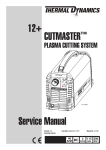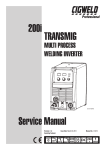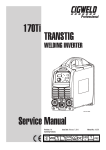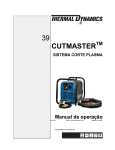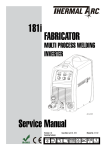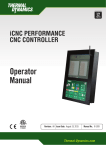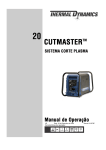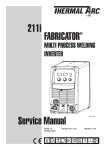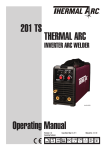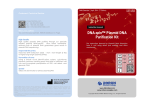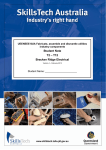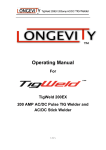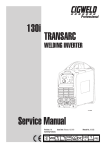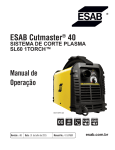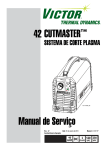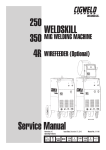Download Service Manual CUTMASTER™ 10mm 12mm
Transcript
10mm 12mm CUTMASTER ™ plasma cutting system 30 20 CUTMAST 40 A ER ® Art # A-11083 Service Manual Revision: AB Operating Features: Issue Date: May 27, 2013 30 40 AMP AMP Manual No.: 0-5230 DC 1 PHASE 240 WE APPRECIATE YOUR BUSINESS! Congratulations on your new Thermal Dynamics product. We are proud to have you as our customer and will strive to provide you with the best service and reliability in the industry. This product is backed by our extensive warranty and world-wide service network. To locate your nearest distributor or service provider call +1300 654 674 (Asia Pacific), +1800-462-2782 (Americas ) or visit us on the web at www.cigweld.com.au (Asia Pacific) www.thermaldynamics.com (Americas and Europe) This Service Manual has been designed to instruct you on the correct use and operation of your Thermal Dynamics product. Your satisfaction with this product and its safe operation is our ultimate concern. Therefore please take the time to read the entire manual, especially the Safety Precautions. They will help you to avoid potential hazards that may exist when working with this product. We have made every effort to provide you with accurate instructions, drawings, and photographs of the product(s) we used when writing this manual. However errors do occur and we apologize if there are any contained in this manual. Due to our constant effort to bring you the best products, we may make an improvement that does not get reflected in the manual. If you are ever in doubt about what you see or read in this manual with the product you received, then check for a newer version of the manual on our website or contact our customer support for assistance. YOU ARE IN GOOD COMPANY! The Brand of Choice for Contractors and Fabricators Worldwide. Thermal Dynamics is a Global Brand of manual and automation Plasma Cutting Products for Victor Technologies International, Inc. We distinguish ourselves from our competition through market-leading, dependable products that have stood the test of time. We pride ourselves on technical innovation, competitive prices, excellent delivery, superior customer service and technical support, together with excellence in sales and marketing expertise. Above all, we are committed to developing technologically advanced products to achieve a safer working environment within the welding industry. ! WARNINGS Read and understand this entire Manual and your employer’s safety practices before installing, operating, or servicing the equipment. While the information contained in this Manual represents the Manufacturer's best judgement, the Manufacturer assumes no liability for its use. Plasma Cutting Power Source CutMaster™ 10mm Plant - Part Number 1-4730-6 Cutmaster™ 12mm Plant - Part Number 1-4200-6 SL60 Torch™ Service Manual Number 0-5230 Published by: Thermal Dynamics Corporation 82 Benning Street West Lebanon, New Hampshire, USA 03784 (603) 298-5711 www.victortechnologies.com Copyright 2012, 2013 by Victor Technologies International, Inc. All rights reserved. Reproduction of this work, in whole or in part, without written permission of the publisher is prohibited. The publisher does not assume and hereby disclaims any liability to any party for any loss or damage caused by any error or omission in this Manual, whether such error results from negligence, accident, or any other cause. Publication Date: December 5, 2012 Revision AB Date: May 27, 2013 Record the following information for Warranty purposes: Where Purchased:____________________________________________ Purchase Date:_______________________________________________ Power Supply Serial #:_________________________________________ Torch Serial #:_______________________________________________ i TABLE OF CONTENTS SECTION 1: GENERAL INFORMATION............................................................................ 1-1 1.01 Notes, Cautions and Warnings......................................................................... 1-1 1.02 Important Safety Precautions.......................................................................... 1-1 1.03Publications..................................................................................................... 1-4 1.04 Servicing Hazards............................................................................................ 1-4 1.05 EMF Information.............................................................................................. 1-6 1.06 Declaration of Conformity................................................................................ 1-7 SECTION 2 SYSTEM: INTRODUCTION ...................................................................................... 2-1 2.01 2.02 2.03 2.04 2.05 2.06 How to Use This Manual.................................................................................. 2-1 Equipment Identification.................................................................................. 2-1 Receipt of Equipment....................................................................................... 2-1 Transportation Methods................................................................................... 2-1 Working Principle............................................................................................ 2-2 Power Supply Features.................................................................................... 2-3 SECTION 2TORCH: INTRODUCTION ..................................................................................... 2T-1 2T.01 Scope of Manual.............................................................................................2T-1 2T.02Specifications ................................................................................................2T-1 2T.03 Introduction to Plasma...................................................................................2T-2 SECTION 3: INSTALLATION ........................................................................................ 3-1 3.01Unpacking........................................................................................................ 3-1 3.02 Lifting Options................................................................................................. 3-1 3.03 Air Supply Connections................................................................................... 3-2 3.04 Power Source Specifications........................................................................... 3-3 3.05 Input Wiring Specifications.............................................................................. 3-5 SECTION 4 SYSTEM: OPERATION............................................................................................ 4-1 4.01 4.02 4.03 4.04 4.05 Control Panel................................................................................................... 4-1 Preparations for Operating............................................................................... 4-2 Sequence of Operation..................................................................................... 4-4 Cut Quality....................................................................................................... 4-6 General Cutting Information............................................................................. 4-7 SECTION 5: THEORY OF OPERATION............................................................................. 5-1 5.01 Inverter Design................................................................................................ 5-1 SECTION 6: TROUBLESHOOTING................................................................................. 6-1 6.01 6.02 6.03 Basic Troubleshooting-Power Source Faults.................................................... 6-1 Checking Unit Before Applying Power............................................................. 6-3 Tools Needed for Troubleshooting and Servicing............................................. 6-3 TABLE OF CONTENTS 6.04 Case Removal.................................................................................................. 6-4 6.05 Visually Inspect................................................................................................ 6-5 6.06 Preliminary Check of the Main Inverter Board................................................. 6-6 6.07 Check Main ON/ OFF Switch............................................................................ 6-8 6.08 Check Pressure Switch.................................................................................... 6-9 6.09 Check Regulator ........................................................................................... 6-10 6.10 Check Main Input Rectifier............................................................................. 6-11 6.11 DC Bus Voltage Measurement....................................................................... 6-12 6.12 Check of Control PCB.................................................................................... 6-13 6.13Waveforms ................................................................................................... 6-16 6.14 Main Circuit Description ............................................................................... 6-17 6.15 Circuit Diagram.............................................................................................. 6-20 SECTION 6 TORCH: SERVICE............................................................................................... 6T-1 6T.01 6T.02 General Maintenance......................................................................................6T-1 Inspection and Replacement of Consumable Torch Parts...............................6T-2 SECTION 7: DISASSEMBLY PROCEDURE........................................................................ 7-1 7.01 7.02 7.03 7.04 7.05 7.06 7.07 Safety Precautions for Disassembly................................................................ 7-1 Control PCB Removal...................................................................................... 7-2 Front Panel Assembly Removal....................................................................... 7-3 Front Panel (Operator Interface) PCB Removal................................................ 7-4 Rear Panel Removal......................................................................................... 7-5 Power Switch S1 and Power Cord Removal.................................................... 7-6 Base Panel Removal........................................................................................ 7-7 SECTION 8: ASSEMBLY PROCEDURES........................................................................... 8-1 8.01 8.02 8.03 8.04 8.05 Installing Base Board....................................................................................... 8-1 Installing Rear Panel........................................................................................ 8-2 Installing Front Panel....................................................................................... 8-4 Installing Main Control PCB and Clear Cover Sheet......................................... 8-5 Installing Case................................................................................................. 8-7 SECTION 9: REPLACEMENT PARTS............................................................................... 9-1 9.02 Power Source Replacement Parts.................................................................... 9-1 9.01Introduction..................................................................................................... 9-1 9.03 SL60 Replacement Parts................................................................................. 9-2 9.04 Options and Accessories................................................................................. 9-2 Statement of Warranty........................................................................................1 GLOBAL CUSTOMER SERVICE CONTACT INFORMATION.................................................3 GENERAL INFORMATION CUTMASTER 10MM, 12MM SECTION 1: GENERAL INFORMATION • The kinds of fumes and gases from the plasma arc depend on the kind of metal being used, coatings on the metal, and the different processes. You must be very careful when cutting or welding any metals which may contain one or more of the following: 1.01 Notes, Cautions and Warnings Throughout this manual, notes, cautions, and warnings are used to highlight important information. These highlights are categorized as follows: Antimony Chromium Mercury ArsenicCobaltNickel Barium Copper Selenium BerylliumLeadSilver Cadmium Manganese Vanadium NOTE An operation, procedure, or background information which requires additional emphasis or is helpful in efficient operation of the system. • Always read the Material Safety Data Sheets (MSDS) that should be supplied with the material you are using. These MSDSs will give you the information regarding the kind and amount of fumes and gases that may be dangerous to your health. CAUTION A procedure which, if not properly followed, may cause damage to the equipment. ! • For information on how to test for fumes and gases in your workplace, refer to item 1 in Subsection 1.03, Publications in this manual. WARNING • Use special equipment, such as water or down draft cutting tables, to capture fumes and gases. A procedure which, if not properly followed, may cause injury to the operator or others in the operating area. • Do not use the plasma torch in an area where combustible or explosive gases or materials are located. • Phosgene, a toxic gas, is generated from the vapors of chlorinated solvents and cleansers. Remove all sources of these vapors. 1.02 Important Safety Precautions ! • This product, when used for welding or cutting, produces fumes or gases which contain chemicals known to the State of California to cause birth defects and, in some cases, cancer. (California Health & Safety Code Sec. 25249.5 et seq.) WARNING OPERATION AND MAINTENANCE OF PLASMA ARC EQUIPMENT CAN BE DANGEROUS AND HAZARDOUS TO YOUR HEALTH. Plasma arc cutting produces intense electric and magnetic emissions that may interfere with the proper function of cardiac pacemakers, hearing aids, or other electronic health equipment. Persons who work near plasma arc cutting applications should consult their medical health professional and the manufacturer of the health equipment to determine whether a hazard exists. ELECTRIC SHOCK Electric Shock can injure or kill. The plasma arc process uses and produces high voltage electrical energy. This electric energy can cause severe or fatal shock to the operator or others in the workplace. • Never touch any parts that are electrically “live” or “hot.” • Wear dry gloves and clothing. Insulate yourself from the workpiece or other parts of the welding circuit. To prevent possible injury, read, understand and follow all warnings, safety precautions and instructions before using the equipment. Call 1-603-298-5711 or your local distributor if you have any questions. • Repair or replace all worn or damaged parts. • Extra care must be taken when the workplace is moist or damp. • Install and maintain equipment according to NEC code, refer to item 9 in Subsection 1.03, Publications on page 1-4. • Disconnect power source before performing any service or repairs. GASES AND FUMES • Read and follow all the instructions in the Operating Manual. Gases and fumes produced during the plasma cutting process can be dangerous and hazardous to your health. • Keep all fumes and gases from the breathing area. Keep your head out of the welding fume plume. • Use an air-supplied respirator if ventilation is not adequate to remove all fumes and gases. Manual 0-5230 1-1 General Information CUTMASTER 10MM, 12MM GENERAL INFORMATION PLASMA ARC RAYS Fire AND EXPLOSION Plasma Arc Rays can injure your eyes and burn your skin. The plasma arc process produces very bright ultra violet and infrared light. These arc rays will damage your eyes and burn your skin if you are not properly protected. Fire and explosion can be caused by hot slag, sparks, or the plasma arc. • Be sure there is no combustible or flammable material in the workplace. Any material that cannot be removed must be protected. • Ventilate all flammable or explosive vapors from the workplace. • To protect your eyes, always wear a welding helmet or shield. Also always wear safety glasses with side shields, goggles or other protective eye wear. • Do not cut or weld on containers that may have held combustibles. • Wear welding gloves and suitable clothing to protect your skin from the arc rays and sparks. • Provide a fire watch when working in an area where fire hazards may exist. • Keep helmet and safety glasses in good condition. Replace lenses when cracked, chipped or dirty. • Hydrogen gas may be formed and trapped under aluminum workpieces when they are cut underwater or while using a water table. DO NOT cut aluminum alloys underwater or on a water table unless the hydrogen gas can be eliminated or dissipated. Trapped hydrogen gas that is ignited will cause an explosion. • Protect others in the work area from the arc rays. Use protective booths, screens or shields. • Use the shade of lens as suggested in the following chart. NOTE These values apply where the actual arc is clearly seen. Experience has shown that lighter filters may be used when the arc is hidden by the workpiece. NOISE Noise can cause permanent hearing loss. Plasma arc processes can cause noise levels to exceed safe limits. You must protect your ears from loud noise to prevent permanent loss of hearing. • To protect your hearing from loud noise, wear protective ear plugs and/or ear muffs. Protect others in the workplace. • Noise levels should be measured to be sure the decibels (sound) do not exceed safe levels. • For information on how to test for noise, see item 1 in Subsection 1.03, Publications, in this manual. General Information 1-2 Manual 0-5230 GENERAL INFORMATION CUTMASTER 10MM, 12MM Recommended Protective Filters for Electric Welding Description of Process Manual Metal Arc Welding - covered electrodes (MMAW) Gas Metal Arc Welding (GMAW) (MIG) other than Aluminium and Stainless Steel Gas Metal Arc Welding (GMAW) (MIG) Aluminium and Stainless Steel Gas Tungsten Arc Welding (GTAW) (TIG) Flux-cored Arc Welding (FCAW) -with or without shielding gas. Air - Arc Gouging Plasma - Arc Cutting Approximate Range of Welding Current in Amps Minimum Shade Number of Filter(s) Less than or equal to 100 8 100 to 200 10 200 to 300 11 300 to 400 12 Greater than 400 13 Less than or equal to 150 10 150 to 250 11 250 to 300 12 300 to 400 13 Greater than 400 14 Less than or equal to 250 12 250 to 350 13 Less than or equal to 100 10 100 to 200 11 200 to 250 12 250 to 350 13 Greater than 350 14 Less than or equal to 300 11 300 to 400 12 400 to 500 13 Greater than 500 14 Less than or equal to 400 12 50 to 100 10 100 to 400 12 400 to 800 14 — 15 Plasma - Arc Spraying Plasma - Arc Welding Less than or equal to 20 8 20 to 100 10 100 to 400 12 400 to 800 14 Submerged - Arc Welding — 2(5) Resistance Welding — Safety Spectacles or eye shield Refer to standard AS/NZS 1338.1:1992 for comprehensive information regarding the above table. Table 1-1 - Protective Filters Manual 0-5230 1-3 General Information CUTMASTER 10MM, 12MM GENERAL INFORMATION 1.03Publications 1.04 Servicing Hazards Refer to the following standards or their latest revisions for more information: ! 1. OSHA, SAFETY AND HEALTH STANDARDS, 29CFR 1910, obtainable from the Superintendent of Documents, U.S. Government Printing Office, Washington, D.C. 20402 The symbols shown below are used throughout this manual to call attention to and identify possible hazards. When you see the symbol, watch out, and follow the related instructions to avoid the hazard. 2. ANSI Standard Z49.1, SAFETY IN WELDING AND CUTTING, obtainable from the American Welding Society, 550 N.W. LeJeune Rd, Miami, FL 33126 Only qualified persons should test, maintain, and repair this unit. 3. NIOSH, SAFETY AND HEALTH IN ARC WELDING AND GAS WELDING AND CUTTING, obtainable from the Superintendent of Documents, U.S. Government Printing Office, Washington, D.C. 20402 Only qualified persons should test, maintain, and repair this unit. 4. ANSI Standard Z87.1, SAFE PRACTICES FOR OCCUPATION AND EDUCATIONAL EYE AND FACE PROTECTION, obtainable from American National Standards Institute, 1430 Broadway, New York, NY 10018 WARNING ELECTRIC SHOCK can kill. • Do not touch live electrical parts. 5. ANSI Standard Z41.1, STANDARD FOR MEN’S SAFETY-TOE FOOTWEAR, obtainable from the American National Standards Institute, 1430 Broadway, New York, NY 10018 • Turn Off cutting power source and disconnect and lockout input power using line disconnect switch, circuit breakers, or by removing plug from receptacle, or stop engine before servicing unless the procedure specifically requires an energized unit. 6. ANSI Standard Z49.2, FIRE PREVENTION IN THE USE OF CUTTING AND WELDING PROCESSES, obtainable from American National Standards Institute, 1430 Broadway, New York, NY 10018 • Insulate yourself from ground by standing or working on dry insulating mats big enough to prevent contact with the ground. 7. AWS Standard A6.0, WELDING AND CUTTING CONTAINERS WHICH HAVE HELD COMBUSTIBLES, obtainable from American Welding Society, 550 N.W. LeJeune Rd, Miami, FL 33126 • Do not leave live unit unattended. • If this procedure requires and energized unit, have only personnel familiar with and following standard safety practices do the job. 8. NFPA Standard 51, OXYGEN-FUEL GAS SYSTEMS FOR WELDING, CUTTING AND ALLIED PROCESSES, obtainable from the National Fire Protection Association, Batterymarch Park, Quincy, MA 02269 • When testing a live unit, use the one-hand method. Do not put both hands inside unit. Keep one hand free. 9. NFPA Standard 70, NATIONAL ELECTRICAL CODE, obtainable from the National Fire Protection Association, Batterymarch Park, Quincy, MA 02269 • Disconnect input power conductors from de-energized supply line BEFORE moving a cutting power source. SIGNIFICANT DC VOLTAGE exists after removal of input power on inverters. 10.NFPA Standard 51B, CUTTING AND WELDING PROCESSES, obtainable from the National Fire Protection Association, Batterymarch Park, Quincy, MA 02269 • Turn Off inverters, disconnect input power, and discharge input capacitors according to instructions in Troubleshooting Section before touching any parts. 11. CGA Pamphlet P-1, SAFE HANDLING OF COMPRESSED GASES IN CYLINDERS, obtainable from the Compressed Gas Association, 1235 Jefferson Davis Highway, Suite 501, Arlington, VA 22202 WARNING 12. CSA Standard W117.2, CODE FOR SAFETY IN WELDING AND CUTTING, obtainable from the Canadian Standards Association, Standards Sales, 178 Rexdale Boulevard, Rexdale, Ontario, Canada M9W 1R3 STATIC (ESD) can damage PC boards. • Put on grounded wrist strap BEFORE handling boards or parts. 13. NWSA booklet, WELDING SAFETY BIBLIOGRAPHY obtainable from the National Welding Supply Association, 1900 Arch Street, Philadelphia, PA 19103 • Use proper static-proof bags and boxes to store, move, or ship PC boards. 14. American Welding Society Standard AWSF4.1, RECOMMENDED SAFE PRACTICES FOR THE PREPARATION FOR WELDING AND CUTTING OF CONTAINERS AND PIPING THAT HAVE HELD HAZARDOUS SUBSTANCES, obtainable from the American Welding Society, 550 N.W. LeJeune Rd, Miami, FL 33126 WARNING FIRE OR EXPLOSION hazard. • Do not place unit on, over, or near combustible surfaces. 15. ANSI Standard Z88.2, PRACTICE FOR RESPIRATORY PROTECTION, obtainable from American National Standards Institute, 1430 Broadway, New York, NY 10018 General Information WARNING • Do not service unit near flammables. 1-4 Manual 0-5230 GENERAL INFORMATION CUTMASTER 10MM, 12MM WARNING WARNING MOVING PARTS can cause injury, FLYING METAL or DIRT can injure eyes. • Wear safety glasses with side shields or face shield during servicing. • Keep away from moving parts such as fans. • Be careful not to short metal tools, parts, or wires together during testing and servicing. • Have only qualified persons remove panels, covers, or guards for maintenance as necessary. • Keep away from pinch points such as drive rolls. • Keep hands, hair, loose clothing, and tools away from moving parts. WARNING • Reinstall panels, covers, or guards when maintenance is finished and before reconnecting input power. HOT PARTS can cause sever burns. • Do not touch hot parts bare handed. • Allow cooling period before working on equipment. WARNING • To handle not parts, use proper tools and/or wear heavy, insulated welding gloves and clothing to prevent burns. OVERUSE can cause OVERHEATING. • Allow cooling period; follow rated duty cycle. • Reduce current or reduce duty cycle before starting to cut again. WARNING • Do not block or filter airflow to unit. EXPLODING PARTS can cause injury. ! • Failed parts can explode or cause other parts to explode when power is applied to inverters. • Always wear a face shield and long sleeves when servicing inverters. WARNING READ INSTRUCTIONS. • Use Testing Booklet (Part No. 150 853) when servicing this unit. • Consult the Owner’s Manual for cutting safety precautions. WARNING • Use only genuine replacement parts from the manufacturer SHOCK HAZARD from testing. • Turn Off cutting power source or stop engine before making or changing meter lead connections. • Use at least one meter lead that has a self-retaining spring clip such as an alligator clip. • Read instructions for test equipment. WARNING FALLING UNIT can cause injury. • Use lifting eye to lift unit only, NOT running gear, gas cylinders, or any other accessories. • Use equipment of adequate capacity to lift and support unit. • If using lift forks to move unit, be sure forks are long enough to extend beyond opposite side of unit. Manual 0-5230 1-5 General Information CUTMASTER 10MM, 12MM GENERAL INFORMATION 1.05 EMF Information Considerations About Cutting And The Effects Of High Frequency Electric And Magnetic Fields Cutting current, as it flows through cutting cables, will cause electromagnetic fields. There has been and still is some concern about such fields. However, after examining more than 500 studies spanning 17 years of research, a special blue ribbon committee of the National Research Council concluded that: “The body of evidence, in the committee’s judgment, has not demonstrated that exposure to power-frequency electric and magnetic fields is a human-health hazard.” However, studies are still going forth and evidence continues to be examined. Until the final conclusions of the research are reached, you may wish to minimize your exposure to electromagnetic fields when welding or cutting. WARNING H.F. RADIATION can cause interference. • High-frequency (H.F.) can interfere with radio navigation, safety services, computers, and communications equipment. • Have only qualified persons familiar with electronic equipment install, test, and service H.F. producing units. • The user is responsible for having a qualified electrician promptly correct any interference problem resulting from the installation. • If notified by the FCC about interference, stop using the equipment at once. • Have the installation regularly checked and maintained. • Keep high-frequency source doors and panels tightly shut, keep spark gaps at correct setting, and use grounding and shielding to minimize the possibility of interference. About Implanted Medical Devices: WARNING MAGNETIC FIELDS can affect Implanted Medical Devices. • Wearers of Pacemakers and other Implanted Medical Devices should keep away from servicing areas until consulting their doctor and the device manufacturer. To reduce magnetic fields in the workplace, use the following procedures: 1. Keep cables close together by twisting or taping them, or using a cable cover. 2. Arrange cables to one side and away from the operator. 3. Do not coil or drape cables around your body. 4. Keep cutting power source and cables as far away from operator as practical. 5. Connect work clamp to workpiece as close to the weld as possible. General Information 1-6 Manual 0-5230 GENERAL INFORMATION CUTMASTER 10MM, 12MM 1.06 Declaration of Conformity Manufacturer: Victor Technologies International, Inc. Address: 82 Benning Street West Lebanon, New Hampshire 03784 USA The equipment described in this manual conforms to all applicable aspects and regulations of the ‘Low Voltage Directive’ (European Council Directive 2006/95/EC) and to the National legislation for the enforcement of this Directive. The equipment described in this manual conforms to all applicable aspects and regulations of the "EMC Directive" (European Council Directive 2004/108/EC) and to the National legislation for the enforcement of this Directive. Serial numbers are unique with each individual piece of equipment and details description, parts used to manufacture a unit and date of manufacture. National Standard and Technical Specifications The product is designed and manufactured to a number of standards and technical requirements. Among them are: • CSA (Canadian Standards Association) standard C22.2 number 60 for Arc welding equipment. • UL (Underwriters Laboratory) rating 94VO flammability testing for all printed-circuit boards used. • CENELEC EN50199 EMC Product Standard for Arc Welding Equipment. • ISO/IEC 60974-1 (BS 638-PT10) (EN 60 974-1) (EN50192) (EN50078) applicable to plasma cutting equipment and associated accessories. • IEC 60974-10 applicable to Industrial Equipment - generic emissions and regulations • AS 1674 Safety in welding and allied processes. • 2001/95/EC RoHS directive. • AS60974.1 Arc Welding Equipment Welding Power Sources. For environments with increased hazard of electrical shock, Power Supplies bearing the S mark conform to EN50192 when used in conjunction with hand torches with exposed cutting tips, if equipped with properly installed standoff guides. • Extensive product design verification is conducted at the manufacturing facility as part of the routine design and manufacturing process. This is to ensure the product is safe, when used according to instructions in this manual and related industry standards, and performs as specified. Rigorous testing is incorporated into the manufacturing process to ensure the manufactured product meets or exceeds all design specifications. Victor Technologies has been manufacturing products for more than 30 years, and will continue to achieve excellence in our area of manufacture. Manual 0-5230 1-7 General Information CUTMASTER 10MM, 12MM GENERAL INFORMATION Notes General Information 1-8 Manual 0-5230 INTRODUCTION CUTMASTER 10MM, 12MM SECTION 2 SYSTEM: INTRODUCTION 2.01 How to Use This Manual 2.02 Equipment Identification To ensure safe operation, read the entire manual, including the chapter on safety instructions and warnings. Throughout this manual, the word WARNING, CAUTION and NOTE may appear. Pay particular attention to the information provided under these headings. These special annotations are easily recognized as follows: The unit’s identification number (specification or part number), model, and serial number usually appear on a nameplate attached to the machine. Equipment which does not have a nameplate attached to the machine is identified only by the specification or part number printed on the shipping container. Record these numbers for future reference. NOTE Offers helpful information concerning certain operating procedures. Notes will be shown in italics CAUTION Refers to possible equipment damage. Cautions will be shown in bold type. ! WARNING Gives information regarding possible personal injury. Warnings will be enclosed in a box such as this. You will also notice icons from the safety section appearing throughout the manual. These are to advise you of specific types of hazards or cautions related to the portion of information that follows. Some may have multiple hazards that apply and would look something like this: Manual 0-5230 2.03 Receipt of Equipment When you receive the equipment, check it against the invoice to make sure it is complete and inspect the equipment for possible damage due to shipping. If there is any damage, notify the carrier immediately to file a claim. Furnish complete information concerning damage claims or shipping errors to the location in your area listed in the inside back cover of this manual. Include all equipment identification numbers as described above along with a full description of the parts in error. 2.04 Transportation Methods ! Disconnect input power conductors from de-energized supply line before moving the cutting power source. Lift unit with handle on top of case. Use handcart or similar device of adequate capacity. If using a fork lift vehicle, secure the unit on a proper skid before transporting. 2-1 Introduction CUTMASTER 10MM, 12MM INTRODUCTION 2.05 Working Principle Rectifier Compressed air Transformer Inverter Reduce pressure, filter Gas valve Rectifier Cutting torch Workpiece Art # A-09204_AB Figure 2-1- Working Principle Introduction 2-2 Manual 0-5230 INTRODUCTION CUTMASTER 10MM, 12MM 2.06 Power Supply Features 240 VAC Power Source Air Inlet To Air Supply (clean/dry) Control Panel 30 20 CUTMASTER 40 ® Art # A-10217 Torch Lead Work Cable and Clamp Figure 2-2- Power Supply Features On/Off Switch Air Inlet, 1/4” NPT Power Cord Art# A-10225 Figure 2-3- Rear with Plug Manual 0-5230 2-3 Introduction CUTMASTER 10MM, 12MM INTRODUCTION Notes Introduction 2-4 Manual 0-5230 INTRODUCTION cutmaster 10MM, 12MM SECTION 2TORCH: INTRODUCTION G. Current Ratings SL60 Current Ratings Up to 60 Amps, DC, Straight Polarity SL60 Torch & Leads 2T.01Scope of Manual This manual contains descriptions, operating instructions and maintenance procedures for the SL60 Plasma Cutting Torch. Service of this equipment is restricted to properly trained personnel; unqualified personnel are strictly cautioned against attempting repairs or adjustments not covered in this manual, at the risk of voiding the Warranty. Read this manual thoroughly. A complete understanding of the characteristics and capabilities of this equipment will assure the dependable operation for which it was designed. 2T.02Specifications A. Torch Configurations 1. Hand Torch, Model SL60 The hand torch head is at 75° to the torch handle. The hand torches include a torch handle and torch trigger assembly. NOTE Power Supply characteristics will determine material thickness range. H. Gas Requirements SL60 Torch Gas Specifications Gas (Plasma and Secondary) Compressed Air Operating Pressure Refer to NOTE 60-75 psi 4.1 - 5.2 bar Maximum Input Pressure 125 psi / 8.6 bar Gas Flow 300-500 scfh 142-235 lpm ! 10.125" (257 mm) WARNING This torch is not to be used with oxygen (O2). This torch is not to be use with high frequency starting systems. 3.75" (95 mm) NOTE Art # A-03322_AB Operating pressure varies with torch model, operating amperage, and torch leads length. Refer to gas pressure settings charts for each model. 1.17" (29 mm) Figure 2T-1 - SL60 Torch B. Torch Leads Lengths Hand Torches are available as follows: • 20 ft / 6.2 m. C. Torch Parts Starter Cartridge, Electrode, Tip, Shield Cup (See "Figure 4-3 - SL60 Torch Parts" on page 4-2.) D. Parts - In - Place (PIP) Torch has built-in switch. 12 vdc circuit rating E. Type Cooling Combination of ambient air and gas stream through torch. F. Torch Ratings SL60 Torch Ratings Ambient Temperature 104° F 40° C Duty Cycle 100% @ 60 Amps @ 400 scfh Maximum Current 60 Amps Voltage (Vpeak) 500V Arc Striking Voltage 7kV Manual 0-5230 2T-1 Introduction CUTMASTER 10MM, 12MM INTRODUCTION D. Main Cutting Arc 2T.03Introduction to Plasma A. Plasma Gas Flow Plasma is a gas which has been heated to an extremely high temperature and ionized so that it becomes electrically conductive. The plasma arc cutting and gouging processes use this plasma to transfer an electrical arc to the workpiece. The metal to be cut or removed is melted by the heat of the arc and then blown away. While the goal of plasma arc cutting is separation of the material, plasma arc gouging is used to remove metals to a controlled depth and width. In a Plasma Cutting Torch a cool gas enters Zone B, where a arc between the electrode and the torch tip heats and ionizes the gas. The main cutting arc then transfers to the workpiece through the column of plasma gas in Zone C. By forcing the plasma gas and electric arc through a small orifice, the torch delivers a high concentration of heat to a small area. The stiff, constricted plasma arc is shown in Zone C. Direct current (DC) straight polarity is used for plasma cutting, as shown in the illustration. DC power is also used for the main cutting arc. The negative output is connected to the torch electrode through the torch lead. The positive output is connected to the workpiece via the work cable and to the torch through a pilot wire. E. Parts - In - Place (PIP) The torch includes a 'Parts - In - Place' (PIP) circuit. When the shield cup is properly installed, it closes a switch. The torch will not operate if this switch is open. To Control Cable Wiring Torch Switch PIP Switch A-09595 Torch Trigger Shield Cup Parts - In - Place Circuit Diagram for Hand Torch Zone A channels a secondary gas that cools the torch. This gas also assists the high velocity plasma gas in blowing the molten metal out of the cut allowing for a fast, slag - free cut. _ Power Supply + A B Workpiece C A-00002 Typical Torch Head Detail B. Gas Distribution The single gas used is internally split into plasma and secondary gases. The plasma gas flows into the torch through the negative lead, through the starter cartridge, around the electrode, and out through the tip orifice. The secondary gas flows down around the outside of the torch starter cartridge, and out between the tip and shield cup around the plasma arc. C. Pilot Arc When the torch is started a pilot arc is established between the electrode and cutting tip. This pilot arc creates a path for the main arc to transfer to the work. Introduction 2T-2 Manual 0-5230 INSTALLATION CUTMASTER 10MM, 12MM SECTION 3: INSTALLATION 3.01Unpacking 1. Use the packing lists to identify and account for each item. A. Contents List for CutMaster 10mm Plant Part No. 1-4730-6 Description Quantity CM 10mm Power Source 1 Work cable and clamp 5m (installed) 1 Carry bag 1 SL60 Torch (Including SL60 Torch 20 ft/6.2m w/ATC, consumables 1 set, spare parts kit) Shoulder Strap 1 Operating Manual 1 Table 3-1- Contents List for CutMaster 10mm Plant B. Contents List for CutMaster 12mm Plant Part No. 1-4200-6 Description Quantity CM 12mm Power Source 1 Work cable and clamp 5m (installed) 1 Carry bag 1 SL60 Torch (Including SL60 Torch 20 ft/6.2m w/ATC, consumables 1 set, spare parts kit) Shoulder Strap 1 Operating Manual 1 Table 3-2- Contents List for CutMaster 12mm Plant 2. Inspect each item for possible shipping damage. If damage is evident, contact your distributor and / or shipping company before proceeding with the installation. 3. Record Power Source and Torch model and serial numbers, purchase date and vendor name, in the information block at the front of this manual. 3.02 Lifting Options The Power Source includes a handle for hand lifting only. Be sure unit is lifted and transported safely and securely. HANDLE is not for mechanical lifting. • Only persons of adequate physical strength should lift the unit. • Lift unit by the handle, using two hands. Do not use straps for lifting. WARNING • Use optional cart or similar device of adequate capacity to move unit. DO NOT touch live electrical parts. Disconnect input power cord before moving unit. ! • Place unit on a proper skid and secure in place before transporting with a fork lift or other vehicle. WARNING FALLING EQUIPMENT can cause serious personal injury and can damage equipment. Manual 0-5230 3-1 Installation CUTMASTER 10MM, 12MM INSTALLATION 3.03 Air Supply Connections A. Connecting Air Supply to Unit The connection is the same for compressed air or industrial compressed air in gas cylinders. 1. Connect the gas line to the compressed air inlet port at the appropriate pressure. On/Off Switch B. Using Industrial Compressed Air In Gas Cylinders When using industrial compressed air in gas cylinders as the gas supply: 1. Refer to the manufacturer’s specifications for installation and maintenance procedures for high pressure gas regulators. Air Inlet, 1/4” NPT 2. Examine the cylinder valves to be sure they are clean and free of oil, grease or any foreign material. Briefly open each cylinder valve to blow out any dust which may be present. 3. The cylinder must be equipped with an adjustable high-pressure regulator capable of outlet pressures up to 100 psi (6.9 bar) maximum and flows of at least 250 scfh [Standard cubic foot per hour] (120 lpm) [liter per minute]. 4. Connect gas supply hose to the cylinder. NOTE Pressure should be set at 100 psi (6.9 bar) at the high pressure gas cylinder regulator. Supply hose must be at least 1/4 inch (6mm) internal diameter. For a secure seal, apply thread sealant to the fitting threads, according to manufacturer's instructions. DO NOT use Teflon tape as a thread sealer, as small particles of the tape may break off and block the small gas passages in the torch. Art # A-10223 Figure 3-1 - Gas Connection to Compressed Air Input Filter Hose Single-Stage Filter Kit No. 7-7507 Hose Clamp 1/4 NPT Hose Fitting ART# A-10675 Gas Supply Hose Figure 3-2 - Optional Single - Stage Filter Installation for Compressed Air Input Installation 3-2 Manual 0-5230 INSTALLATION CUTMASTER 10MM, 12MM 3.04 Power Source Specifications A. CutMaster 10mm Plant Part No. 1-4730-6 CUTMASTER 10mm Power Source Specifications Input Power 240 VAC (+/-15%), 1 Phase, 50/60Hz Output Current 20-30 Amps @ 240VAC CUTMASTER 10mm Power Source Duty Cycle (Note 1) Ambient Temperature 104° F (40° C) Duty Cycle 40% @ 240VAC Rated Current 30 Amps @ 240VAC SL60 Torch Gas Requirements (See Section 2T.02) Note Note 1: Duty Cycle is the percentage of time the system can be operated without overheating. Duty cycle is reduced if primary input voltage (AC) is low or the DC voltage is higher than shown in this chart. Note 2: Air supply must be free of oil, moisture, and other contaminants. Excessive oil and moisture may cause double-arcing, rapid tip wear, or even complete torch failure. Contaminants may cause poor cutting performance and rapid electrode wear. Optional filters provide increased filtering capabilities. Table 3-3- CUTMASTER 10mm Plant Power Source Specifications B. CutMaster 12mm Plant Part No. 1-4200-6 CUTMASTER 12mm Power Source Specifications Input Power 240 VAC (+-15%), 1 Phase, 50/60Hz Output Current 20-40 Amps @ 240VAC CUTMASTER 12mm Power Source Duty Cycle (Note 1) Ambient Temperature 104° F (40° C) Duty Cycle 40% @ 240VAC Rated Current 40 Amps @ 240VAC SL60 Torch Gas Requirements (See Section 2T.02) Note Note 1: Duty Cycle is the percentage of time the system can be operated without overheating. Duty cycle is reduced if primary input voltage (AC) is low or the DC voltage is higher than shown in this chart. Note 2: Air supply must be free of oil, moisture, and other contaminants. Excessive oil and moisture may cause double-arcing, rapid tip wear, or even complete torch failure. Contaminants may cause poor cutting performance and rapid electrode wear. Optional filters provide increased filtering capabilities. Table 3-4- CUTMASTER 12mm Plant Power Source Specifications NOTE IEC Rating is determined as specified by the International Electro-Technical Commission. These specifications include calculating an output voltage based upon power supply rated current. To facilitate comparison between power supplies, all manufacturers use this output voltage to determine duty cycle. TDC Rating is determined using an output voltage representative of actual output voltage during cutting with a TDC torch. This voltage may be more or less than IEC voltage, depending upon choice of torch, consumables, and actual cutting operation. Manual 0-5230 3-3 Installation CUTMASTER 10MM, 12MM INSTALLATION 9" (228.6mm) 30 20 CUTMASTER 40 A ® 18.5" (469.9mm) Art # A-10216 7" (177mm) 26lb / 11.8kg Figure 3-3 - Power Source Dimensions & Weight NOTE Weight includes torch & leads, input power cord, and work cable with clamp. CAUTION Provide clearance for proper air flow through the Power Source. Operation without proper air flow will inhibit proper cooling and reduce duty cycle. Installation 3-4 Manual 0-5230 INSTALLATION CUTMASTER 10MM, 12MM 3.05 Input Wiring Specifications CUTMASTER 10mm Input Power Requirements Input Power Input Current Input Current Input Suggested Sizes (See Note) Voltage Frequency (kVA) Max (Amps) I1eff (Amps) Fuse (Amps) (Volts-AC) (Hz) 1-Ph 1-Ph 1-Ph 1-Ph 240 50/60 3.8 15.6 9.9 16 Line Voltages with Suggested Circuit Protection Motor start fuses or thermal circuit breakers are recommended for this application. Check local requirements for your situation in this regard. CUTMASTER 12mm Input Power Requirements Input Power Input Current Input Current Input Suggested Sizes (See Note) Voltage Frequency (kVA) Max (Amps) I1eff (Amps) Fuse (Amps) (Volts-AC) (Hz) 1-Ph 1-Ph 1-Ph 1-Ph 240 50/60 5.0 20.8 13 16 Line Voltages with Suggested Circuit Protection Motor start fuses or thermal circuit breakers are recommended for this application. Check local requirements for your situation in this regard. NOTE Refer to Local and National Codes or local authority having jurisdiction for proper wiring requirements. Cable size is de-rated based on the Duty Cycle of the equipment. The suggested sizes are based on flexible power cable with power plug installations. Cable conductor temperature used is 167° F (75° C). Manual 0-5230 3-5 Installation CUTMASTER 10MM, 12MM INSTALLATION Notes Installation 3-6 Manual 0-5230 OPERATION CUTMASTER 10MM, 12MM SECTION 4 SYSTEM: OPERATION 4.01 Control Panel AC Indicator DC Indicator (Ready) On/Off Switch Air Inlet, 1/4” NPT Power Cord Air Indicator Overheat Indicator 30 20 CUTMASTER ® 40 A 12mm Art # A-10218 Figure 4-1 - Front Control Panel Figure 4-2 - Rear Controls 1. ON/OFF Switch (Power Switch) Controls input power to the Power Source. I is ON, O is OFF. 2. (A) Output Current Control Sets the desired output current. If the overload protection (fuse or circuit breaker) on the input power circuit opens frequently, either reduce cutting output, reduce the cutting time, or connect the unit to more adequate input power. For 240V input power, the maximum output is 40 Amps. Refer to Section 2 for input power requirements. 3. AC Indicator Steady light indicates Power Source is ready for operation. 4. OVERHEAT Indicator (TEMP Indicator) Indicator is normally OFF. Indicator is ON when internal temperature exceeds normal limits. Allow the unit to run with the fan on until the temp indicator turns OFF. 5. AIR Indicator AIR indicator light should be ON when there is sufficient gas pressure. 6. READY (DC Indicator) Indicator is ON when DC output circuit is active. Manual 0-5230 4-1 Operation CUTMASTER 10MM, 12MM OPERATION 4.02 Preparations for Operating At the start of each operating session: WARNING Disconnect primary power at the source before assembling or disassembling Power Source, torch parts, or torch and leads assemblies. NOTE All consumables must be correctly installed and maintained to ensure correct operation. A. Torch Parts Selection Check the torch for proper assembly and appropriate torch parts. The torch parts must correspond with the type of operation, and with the amperage output of this Power Source (40 amps maximum). Use only genuine Thermal Dynamics parts with this torch. Art # A-10224 Electrode, OTD9/8215 Start Cartridge, Part No. OTD9/8213 40 Amp Standoff Tip, Part No. OTD9/8208 40 Amp Drag Tip, Part No. OTD9/8207 (fitted) Shield Cup, Part No. OTD9/8218 Worn Electrode Worn Tip Figure 4-3 - SL60 Torch Parts NOTE When operating the torch in a normal condition, some gas vents through the gap between the shield cup and torch handle. DO NOT attempt to over tighten the shield cup as irreparable damage to internal components may result. Operation 4-2 Manual 0-5230 OPERATION CUTMASTER 10MM, 12MM B. Torch Connection Check that the torch is properly connected. C. Check Primary Input Power Source 1. Check the power source for proper input voltage. Make sure the input power source meets the power requirements for the unit per Section 2, Specifications. 2. Connect the input power cable (or close the main disconnect switch) to supply power to the system. D. Gas Selection 1. Ensure gas source meets requirements listed in Section 2T. 2. Check connections and turn gas supply on. E. Connect Work Cable Clamp the work cable to the workpiece or cutting table. The area must be free from oil, paint and rust. Connect only to the main part of the workpiece; do not connect to the part to be cut off. Art # A-03387 Figure 4-4 - Work Cable Connection F.Power On Place the Power Source ON/OFF switch to the ON (I) position. Power indicator On/Off Switch turns ON. Air Inlet, 1/4” NPT Power Cord Power indicator 30 20 Art# A-10225 Art# A-10219 A Figure 4-6 - Front Panel with Power ON/OFF Indicator Figure 4-5 - Rear Panel with ON/OFF Switch Manual 0-5230 40 4-3 Operation CUTMASTER 10MM, 12MM OPERATION 4.03 Sequence of Operation The following is a typical sequence of operation for this Power Source. 1. Place the ON/OFF switch on the Power Source to ON (up) position. a. AC indicator turns on; fan turns on. NOTE During initial power up, there will be a delay of about 2 seconds before the AC Indicator light will illuminate and the pre-flow gas and fan starts. The gas will automatically flow from torch for approximately 10 seconds (only after the AC Indicator lamp is illuminated) (The AC Indicator lamp and fan turns on approximately 2 seconds after the ON/OFF switch is enabled), this is a process that makes sure all inputs (gas, input power, torch connection, and torch parts) are acknowledged for proper operation. 2. Wear protective clothing, including welding gloves and appropriate eye protection (See Table 1-1). Place tip on workpiece and pull trigger. Arc will initiate and start cutting material. • Standoff Cutting With Hand Torch Torch NOTE For best performance and parts life, always use the correct parts for the type of operation. A. The torch can be comfortably held in one hand or steadied with two hands. Position the hand to press the Trigger on the torch handle. With the hand torch, the hand may be positioned close to the torch head for maximum control or near the back end for maximum heat protection. Choose the holding technique that feels most comfortable and allows good control and movement. NOTE Shield Cup Standoff Distance 1/8" - 3/8" (3 - 9mm) A-00024_AB Figure 4-8 Standoff Distance Trigger The tip should never come in contact with the workpiece except during drag cutting operations. 1 2 Trigger Release B. Depending on the cutting operation, do one of the following: a). For drag cutting, place the tip on the plate holding the torch at an angle to the plate so that only one edge of the tip is in contact with the plate. This prevents damage to the tip during the piercing process. b). For standoff cutting, hold the torch tip on the workpiece, pull the trigger. After the arc is initiated lift the tip to 1/8" - 3/8" (3-4mm) off the work. 3 4 Art # A-11462 Figure 4-9 Standoff Cutting Art # A-09342 NOTE When the shield cup is properly installed, there is a slight gap between the shield cup and the torch handle. Gas vents through this gap as part of normal operation. DO NOT attempt to force the shield cup to close this gap. Forcing the shield cup against the torch head or torch handle can damage components. Trigger Trigger Release Figure 4-7 Torch Trigger Release Operation 4-4 Manual 0-5230 OPERATION CUTMASTER 10MM, 12MM • Drag Cutting With a Hand Torch Drag cutting works best on metal 1/4" (6mm) thick or less. NOTE Trigger 1 2 For best parts performance and life, always use the correct parts for the type of operation. Trigger Release A. Install the drag cutting tip and set the output current. B. The torch can be comfortably held in one hand or steadied with two hands. Position the hand to press the Trigger on the torch handle. With the hand torch, the hand may be positioned close to the torch head for maximum control or near the back end for maximum heat protection. Choose the holding technique that feels most comfortable and allows good control and movement. C. Keep the torch in contact with the workpiece during the cutting cycle. D. Hold the torch away from your body. E. Slide the trigger release toward the back of the torch handle while simultaneously squeezing the trigger. The arc will start. 3 4 Art# A-09341 Figure 4-11 - Drag Cutting G. Cut as usual. Simply release the trigger assembly to stop cutting. H. Follow normal recommended cutting practices as provided herein. 3. Complete cutting operation. NOTE If the torch is lifted too far from the workpiece while cutting, the main arc will stop and the pilot arc will automatically restart. Art # A-09342 4. Release the torch trigger. a. Main arc stops. 5. Set the Power Source ON/OFF switch to OFF (down position). turns OFF. a. AC indicator 6. Set the main power disconnect to OFF, or unplug input power cord. a. Input power is removed from the system. Trigger Trigger Release Figure 4-10 - Torch Trigger Release F. Place the torch tip on the work. The main arc will transfer to the work. NOTE The gas preflow and postflow are a characteristic of the Power Source and not a function of the torch. Manual 0-5230 4-5 Operation CUTMASTER 10MM, 12MM Bottom Dross Buildup 4.04 Cut Quality OPERATION Molten material which is not blown out of the cut area and resolidifies on the plate. Excessive dross may require secondary cleanup operations after cutting. NOTE Cut quality depends heavily on setup and parameters such as torch standoff, alignment with the workpiece, cutting speed, gas pressures, and operator ability. Kerf Width The width of the cut (or the width of material removed during the cut). Refer to Appendix pages for additional information as related to the Power Source used. Top Spatter (Dross) Cut quality requirements differ depending on application. For instance, nitride build-up and bevel angle may be major factors when the surface will be welded after cutting. Dross-free cutting is important when finish cut quality is desired to avoid a secondary cleaning operation. The following cut quality characteristics are illustrated in the following figure: Top spatter or dross on the top of the cut caused by slow travel speed, excess cutting height, or cutting tip whose orifice has become elongated. Kerf Width Cut Surface Bevel Angle Top Spatter Top Edge Rounding Dross Build-Up Cut Surface Drag Lines A-00007 Figure 4-12 - Cut Quality Characteristics Cut Surface The desired or specified condition (smooth or rough) of the face of the cut. Nitride Build-Up Nitride deposits can be left on the surface of the cut when nitrogen is present in the plasma gas stream. These buildups may create difficulties if the material is to be welded after the cutting process. Bevel Angle The angle between the surface of the cut edge and a plane perpendicular to the surface of the plate. A perfectly perpendicular cut would result in a 0° bevel angle. Top-Edge Rounding Rounding on the top edge of a cut due to wearing from the initial contact of the plasma arc on the workpiece. Operation 4-6 Manual 0-5230 OPERATION CUTMASTER 10MM, 12MM 4.05 General Cutting Information Direction of Cut In the torches, the plasma gas stream swirls as it leaves the torch to maintain a smooth column of gas. This swirl effect results in one side of a cut being more square than the other. Viewed along the direction of travel, the right side of the cut is more square than the left. WARNING Disconnect primary power at the source before disassembling the power source, torch, or torch leads. Left Side Cut Angle Frequently review the Important Safety Precautions at the front of this manual. Be sure the operator is equipped with proper gloves, clothing, eye and ear protection. Make sure no part of the operator’s body comes into contact with the workpiece while the torch is activated. Right Side Cut Angle A-00512 Figure 4-13 - Side Characteristics of Cut CAUTION Sparks from the cutting process can cause damage to coated, painted, and other surfaces such as glass, plastic and metal. To make a square-edged cut along an inside diameter of a circle, the torch should move counterclockwise around the circle. To keep the square edge along an outside diameter cut, the torch should travel in a clockwise direction. NOTE Handle torch leads with care and protect them from damage. Dross When dross is present on carbon steel, it is commonly referred to as either “high speed, slow speed, or top dross”. Dross present on top of the plate is normally caused by too great a torch to plate distance. "Top dross" is normally very easy to remove and can often be wiped off with a welding glove. "Slow speed dross" is normally present on the bottom edge of the plate. It can vary from a light to heavy bead, but does not adhere tightly to the cut edge, and can be easily scraped off. "High speed dross" usually forms a narrow bead along the bottom of the cut edge and is very difficult to remove. When cutting a troublesome steel, it is sometimes useful to reduce the cutting speed to produce "slow speed dross". Any resultant cleanup can be accomplished by scraping, not grinding. Torch Standoff Improper standoff (the distance between the torch tip and workpiece) can adversely affect tip life as well as shield cup life. Standoff may also significantly affect the bevel angle. Reducing standoff will generally result in a more square cut. Edge Starting For edge starts, hold the torch perpendicular to the workpiece with the front of the tip near (not touching) the edge of the workpiece at the point where the cut is to start. When starting at the edge of the plate, do not pause at the edge and force the arc to "reach" for the edge of the metal. Establish the cutting arc as quickly as possible. Manual 0-5230 4-7 Operation CUTMASTER 10MM, 12MM OPERATION Notes Operation 4-8 Manual 0-5230 THEORY OF OPERATION CUTMASTER 10MM, 12MM SECTION 5: THEORY OF OPERATION 5.01 Inverter Design What does the word inverter mean? The term inverter refers to the ability to change DC power into AC. Inverter power supplies immediately rectify the incoming AC to DC, and then the transistors create a higher frequency AC. The higher frequency AC then goes on to a much smaller main transformer than in a conventional power supply. The AC is then rectified to extremely smooth DC. The diagram to the below shows the basic electrical wiring of a DC output inverter power supply. Inverter Technology-Summary Rectifier Filter IGBT AC-50/60Hz DC- Rippled DC-Smooth High Voltage High Voltage High Voltage Low Amperage Low Amperage Low Amperage Transformer Rectifier Inductor AC-High Frequency AC-High Frequency DC- Rippled High Voltage Low Amperage DC-Smooth Low Voltage Low Voltage Low Voltage High Amperage High Amperage High Amperage Art # A-09846_AB Figure 5-1- Inverter Technology Manual 0-5230 5-1 Theory of Operation CUTMASTER 10MM, 12MM THEORY OF OPERATION Notes Theory of Operation 5-2 Manual 0-5230 TROUBLESHOOTING CUTMASTER 10MM, 12MM SECTION 6: TROUBLESHOOTING 6.01 Basic Troubleshooting-Power Source Faults ! WARNING There are extremely dangerous voltage and power levels present inside this unit. Do not attempt to diagnose or repair it unless you are an accredited service provider and you have had training in power electronics measurement and troubleshooting techniques. Common Faults Symptom LED Indicators A. AC indicator OFF 1. Main input power cord does not connect to power distribution net. a. D. TEMP indicator a. Connect the power cord. a. Have an Accredited CIGWELD service provider repair or replace as required. B. AC indicator a. Check for missing torch parts or not properly installed. Turn ON/OFF switch to OFF position and restart the machine by turning the power switch to ON. 1. Faulty parts in torch a. Check torch parts per section 4.02; replace as needed. 2. Gas pressure too low a. Check for worn or sticking torch parts. Replace if necessary. a. Adjust supply pressure to proper setting value. 3. Faulty components in unit 3. Indicator blinking (3 sec ON/3 Sec OFF). a. Torch switch was depressed before machine was completely powered up. Turn ON/OFF switch to OFF position and restart the machine by turning the power switch to ON. C. Air indicator a. Have an Accredited CIGWELD service provider repair or replace as required. E. Torch will not pilot, when torch trigger is activated. 2. Indicator blinking (1 sec ON/3 Sec OFF). a. Keep the machine plugged in and turned on for five minutes. This will allow the fan to run and cool the machine. 4. Faulty components in unit blinking 1. Indicator blinking (1 sec ON/1 Sec OFF, Gas may also pulse 3 times). a. Check for blocked status and correct condition. 3. Unit is overheated. a. Verify that the input line voltage is correct. 4. Faulty components in unit a. Check for blocked air flow around the unit and correct condition. 2. Fan blocked. Turn switch to ON (up) position. 3. Actual input voltage does not correspond to voltage of unit. ON) 1. Unit air flow obstructed. 2. Power ON/OFF switch in OFF (down) position. ON, (AC indicator a. Have an Accredited CIGWELD service provider repair or replace as required. OFF 1. Gas pressure too low. Check supply pressure. a. Check and adjust to proper setting. Manual 0-5230 6-1 Troubleshooting CUTMASTER 10MM, 12MM TROUBLESHOOTING 2. Working cable connection is poor. F. No cutting output when torch is activated; AC indicator ON, gas flows, fan turns. 1. Torch is not connected properly to power supply. a. ply. Check torch connection to power sup- 2. Working cable not connected to work piece, or connection is poor. a. Make sure that work cable has a proper connection to a clean, dry area of the work piece. 3. Faulty components in unit a. Have an Accredited CIGWELD service provider repair or replace as required. 4. Faulty torch a. Return for repair or have qualified technician repair. 1. Incorrect setting of output current control a. a. Have electrician check input line voltage under load. J. Hard to startup 1. Torch parts worn (consumables) a. Turn off input power, remove shield cup, tip, start cartridge, and electrode and check them all. If the electrode or cutting tip is worn out, replace them. If the start cartridge does not move freely, replace it. If there is too much spatter on shield cup, replace it. 1. Power Supply is overheated (TEMP indicator ON). Check and adjust to proper setting. 2. Working cable connection to work piece is poor. 3. Low or fluctuating input voltage K. Arc goes out while operating. Arc can’t be restarted when torch trigger is activated. G. Torch cuts but not adequately a. Make sure that work cable has a proper connection to a clean, dry area of the work piece. 3. Faulty components in unit 1. Input or output connection is poor. a. Check all input and output connection leads. 2. Working cable connection to work piece is poor. a. Make sure that work cable has a proper connection to a clean, dry area of the work piece. 3. Faulty components in unit a. Have an Accredited CIGWELD service provider repair or replace as required. a. Check for blocked air flow around the unit and correct condition. 4. Gas pressure is too low. (Air indicator when torch trigger is activated.) ON a. Check gas source. Adjust to proper setting value. 5. Torch parts worn a. Check torch shield cup, cutting tip, start cartridge and electrode. Replace as needed. 1. Input or output connection is poor a. Check all input and output connection leads. 6-2 a. Have an Accredited CIGWELD service provider repair or replace as required. L. Torch cuts but not well. 1. Current control is set too low. Troubleshooting Check and clear blades. 6. Faulty component in unit I. Cutting output is unstable or inadequate. a. ON). 3. Air flow blocked H. Output is restricted, and can not be controlled. a. Let unit cool down for at least 5 minutes. Make sure the unit has not been operated beyond duty cycle limit. 2. Fan blades blocked (TEMP indicator a. Return for repair or have qualified technician repair. a. Make sure that work cable has a proper connection to a clean, dry area of the work piece. a. Increase the current setting. Manual 0-5230 TROUBLESHOOTING CUTMASTER 10MM, 12MM 2. Torch is being moved too fast across work piece a. Reduce cutting speed. 3. Excessive oil or moisture in torch a. Hold torch 1/8 inch (3 mm) from clean surface while purging and observe oil or moisture buildup (do not activate torch). If there are contaminants in the gas, additional filtering may be needed. 4. Torch parts worn a. Check torch shield cup, cutting tip, start cartridge and electrode. Replace as needed. M.When torch trigger is activated gas in torch flows and then stops, but will not pilot. AC indicator light blinking. 1. Torch parts not properly installed in torch. There may have been an attempt to remove torch parts without turning off ON/OFF power switch to OFF on unit. a. Turn ON/OFF switch to OFF position and then check to make sure torch parts are properly installed. b. Turn ON/OFF switch to OFF and then back to ON. 6.02 Checking Unit Before Applying Power ! The following safety information shall be read before starting troubleshooting and servicing. 1. Turn SW1 to OFF position, and disconnect unit from primary line voltage before working on unit. 2. Significant DC voltage can remain on capacitors after unit is OFF. Wait until all front panel LED’s are OFF before removing case. 3. Check DC bus voltage according to Section 6.06 after removing case and make sure the DC bus voltage is closed 0V. 4. Before troubleshooting or applying power to unit, complete the checks through 6.05 and 6.14, to avoid causing further damage. 6.03 Tools Needed for Troubleshooting and Servicing Art # A-09849 Figure 6-1 Tools Needed for Troubleshooting and Servicing • Digital Multimeter • DC Clip-on ammeter • Screwdriver and spanner • CRO (20 Mhz bandwidth) & isolating transformer Manual 0-5230 6-3 Troubleshooting CUTMASTER 10MM, 12MM TROUBLESHOOTING 6.04 Case Removal ! WARNING Read and follow safety information in Section 6.02 before proceeding. Remove the ten screws from the case and remove the case panel. Art # A-10242 Figure 6-2 Case Removal View Troubleshooting 6-4 Manual 0-5230 TROUBLESHOOTING CUTMASTER 10MM, 12MM 6.05 Visually Inspect ! WARNING Read and follow safety information in Section 6.02 before proceeding. 1. Take out clear protective sheet over main inverter board. Art # A-10243 1 Figure 6-3 Clear Protective Sheet Removal View 2. Visually inspect the inside of the Power Source. The levels of current present in these units can cause burning or arcing of PCB, transformers, switches, or rectifier when a failure occurs. Carefully inspect all components within these units. Look in particular for the following: a) Loose or broken wires or connectors. b) Burned or scorched parts or wires or evidence of arcing. c) Any accumulation of metal dust or filings that may have caused shorting or arcing. If any parts are damaged, they must be replaced. Refer to the Spare Parts section for a complete list of components used in the Power Source, as well as how to access and remove the failed parts. Locate the faulty component(s) then repair or replace where necessary. Manual 0-5230 6-5 Troubleshooting CUTMASTER 10MM, 12MM TROUBLESHOOTING 6.06 Preliminary Check of the Main Inverter Board ! WARNING 19 20 31 30 17 18 14 13 12 11 29 32 21 16 22 10 9 8 7 6 15 23 5 4 24 3 2 1 25 26 Art # A-10244 Read and follow safety information in Section 6.02 before proceeding. Figure 6-4 Main Inverter Board Troubleshooting 6-6 Manual 0-5230 TROUBLESHOOTING DC Bus Testing Upper capacitor bank Lower capacitor bank IGBT Testing IGBT 1 IGBT 2 IGBT 3 VIGBT 4 PFC IGBT 1 PFC IGBT2 PILOT IGBT1 CUTMASTER 10MM, 12MM Multimeter Lead Placement Voltage with Supply voltage OFF Positive meter lead to TP 30 0 VDC Negative meter lead to TP 29 Positive meter lead to TP 32 0 VDC Negative meter lead to TP 31 Table 6-1 DC BUS, Multimeter Set to Measure DC volts Multimeter Lead Placement Positive meter lead to TP 3 Negative meter lead to TP 2 Positive meter lead to TP 5 Negative meter lead to TP 4 Positive meter lead to TP 8 Negative meter lead to TP 7 Positive meter lead to TP 10 Negative meter lead to TP 9 Positive meter lead to TP 14 Negative meter lead to TP 13 Positive meter lead to TP 12 Negative meter lead to TP 11 Positive meter lead to TP 26 Negative meter lead to TP 25 Diode Voltage 0.2000 to 0.8000 VDC 0.2000 to 0.8000 VDC 0.2000 to 0.8000 VDC 0.2000 to 0.8000 VDC 0.2000 to 0.8000 VDC 0.2000 to 0.8000 VDC 0.2000 to 0.8000 VDC Table 6-2 IGBT’s, Multimeter Set to Measure Diode Voltage Manual 0-5230 6-7 Troubleshooting CUTMASTER 10MM, 12MM TROUBLESHOOTING 6.07 Check Main ON/ OFF Switch ! WARNING Read and follow safety information in Section 6.02 before proceeding. 1 3 2 4 Art # A-10245 Figure 6-5 Main ON/ OFF Switch View Power Switch Testing Switch ON Switch ON Switch OFF Switch OFF Multimeter Lead Placement Positive meter lead to TP 1 Negative meter lead to TP 2 Positive meter lead to TP 3 Negative meter lead to TP 4 Positive meter lead to TP 1 Negative meter lead to TP 2 Positive meter lead to TP 3 Negative meter lead to TP 4 Impedance 0 to 1 Ω 0 to 1 Ω > 1k Ω > 1k Ω Table 6-3 Power Switch, Multimeter set to measure ohms (Ω) Troubleshooting 6-8 Manual 0-5230 TROUBLESHOOTING CUTMASTER 10MM, 12MM 6.08 Check Pressure Switch 1 Art # A-10292 2 Figure 6-6 Pressure Switch View Turn ON the power switch, disconnect the contact of the pressure switch and start the test as below: 1. Pressure switch open When the pressure is up to 3.5kgf/cm2 (49.78 PSI), the pressure switch turns OFF. 2. Pressure switch closed When the pressure is less than 2.4kgf/cm2 (34.13 PSI), the pressure switch turns ON and the resistance between 1 and 2 is about 0.1Ω. Manual 0-5230 6-9 Troubleshooting CUTMASTER 10MM, 12MM TROUBLESHOOTING 6.09 Check Regulator 1 Art # A-10293 Figure 6-7- Regulator View Turn ON the power switch and start the test as below: When solenoid valve is ON,adjust the knob 1. If the pressure is continuously adjustable, the regulator is OK. Troubleshooting 6-10 Manual 0-5230 TROUBLESHOOTING CUTMASTER 10MM, 12MM 6.10 Check Main Input Rectifier AC1 DC— AC2 DC+ Art # A-10291 Figure 6-8 Main Input Rectifier Remove the main input rectifier from the heatsink and start the testing. Input Rectifier Testing AC1 to DC+ AC2 to DC+ AC1 to DCAC2 to DC- Multimeter Lead Placement Positive meter lead to AC1 Negative meter lead to TP DC+ Positive meter lead to AC2 Negative meter lead to TP DC+ Positive meter lead to TP DCNegative meter lead to TP AC1 Positive meter lead to TP DCNegative meter lead to TP AC2 Diode Voltage 0.2 – 0.8 VDC 0.2 – 0.8 VDC 0.2 – 0.8 VDC 0.2 – 0.8 VDC Table 6-4 Input Rectifier, Multimeter Set to Measure Diode Voltage Measurements may be made directly onto the main input rectifier. AC1 and AC2 may be measured from the pins on the mains supply plug with the main power switch set to the ON position. Manual 0-5230 6-11 Troubleshooting CUTMASTER 10MM, 12MM TROUBLESHOOTING 6.11 DC Bus Voltage Measurement Apply voltage to the Power Source. Warning There are extremely dangerous voltage and power levels present inside this Power Source. Do not attempt to diagnose or repair unless you have had training in power electronics measurement and troubleshooting techniques. Once power is applied to the Power Source, there are extremely hazardous voltage and power levels present. Do not touch any live parts. Refer to Figure 6-4 in Section 6.06 for Main Inverter Board. DC Bus Testing Upper capacitor bank Lower capacitor bank Overall capacitor bank Multimeter Lead Placement Voltage with Supply voltage ON Positive meter lead to TP 30 192 VDC +/-10% Negative meter lead to TP 29 Positive meter lead to TP 31 192 VDC +/-10% Negative meter lead to TP 32 Positive meter lead to TP 29 384 VDC +/-10% Negative meter lead to TP 32 Table 6-5 DC BUS, Multimeter Set to Measure DC volts NOTE These DC voltages are at nominal mains supply voltage of 240VAC. Troubleshooting 6-12 Manual 0-5230 TROUBLESHOOTING CUTMASTER 10MM, 12MM 6.12 Check of Control PCB ! WARNING J6(U_D) Art # A-10246 J5(DRIVE) J7(WA) J8(FAN) SW1 J4(SOURCE&TIP) J9(Transf IFB) J3(HFOUT) J10(WV) J2(MB) J11(D_port) J1(HF/QF) GND J12(OT) J13(PRESSURE) J14(GUN&TEST) Read and follow safety information in Section 6.02 before proceeding. Figure 6-9 Control PCB Manual 0-5230 6-13 Troubleshooting CUTMASTER 10MM, 12MM HF/QF Header Pin 1 2 3 4 MB Header Pin 1 2 3 4 5 6 7 8 9 10 TROUBLESHOOTING Pin function Signal GND 0VDC Control circuit power source 27VDC Negative of solenoid control signal 0VDC (when soleniod is on) Positive of solenoid control signal 27VDC Table 6-6 HF/QF Header Pin Function Pin function Current control potentiometer N/A Fault indicator signal N/A Control circuit power supply GND Power indication signal N/A Work indication signal Power indication signal Signal 0 — 4VDC N/A 2VDC (when indication lights up) N/A 5VDC 0VDC 2VDC N/A 2VDC 2VDC Table 6-7 MB Header Pin Function HFOUT Header Pin J3 Pin function N/A Table 6-8 HFOUT Header Pin Function Signal N/A SOURCE & TIP Header Pin 1 2 Pin function Signal Positive of TIP test signal TIP test signal 3 Control circuit power source 5VDC 5VDC (when machine dose no work) 0VDC the machine is woking 24VDC 4 5 GND Control circuit power source Table 6-9 SOURCE & TIP Header Pin Function DRIVE Header Pin 1 2 3 4 5 6 7 U_D Header Pin 1 2 Troubleshooting 0VDC -24VDC Pin function Drive circuit power IGBT 1 pwm drive signal IGBT 2 pwm drive signal IGBT 2 pwm drive signal IGBT 1 pwm drive signal Overcurrent signal Signal +15VDC 15V p-p square wave 15V p-p square wave 15V p-p square wave 15V p-p square wave >7VDC when over primary current protection GND 0VDC Table 6-10 DRIVE Header Pin Function Pin function Feedback of input voltage GND Table 6-11 U_D Header Pin Function 6-14 Signal 41VDC(input 240vac) 0VDC Manual 0-5230 TROUBLESHOOTING CUTMASTER 10MM, 12MM WA Header Pin 1 2 3 4 Pin function Power source of current sensor Power source of current sensor Output current feedback GND Table 6-12 WA Header Pin Function Signal 15VDC -15VDC FAN Header Pin 1 2 Pin function Power source of fan 0VDC(fan negative)when fan is on Table 6-13 FAN Header Pin Function Signal 24VDC 0VDC Transf IFB Header Pin 1 Pin function Pilot ARC current feedback signal Signal -0.8VDC +5VDC( A main cutting arc is established) GND 0VDC N/A N/A Table 6-14 Transf IFB Header Pin Function 2 3 WV Header Pin 1 2 D_port Header Pin 1 2 OT Header Pin 1 2 3 0VDC Pin function Positive of voltage feedback Signal Machine output + Negative of voltage feedback Table 6-15 WV Header Pin Function Machine output _ Pin function +12VDC Pilot ARC IGBT drive signal Table 6-16 D_port Header Pin Function Pin function N/A Thermostat (0VDC when thermostat closed) GND Table 6-17 OT Header Pin Function PRESSURE Header Pin 1 2 Pin function Signal +12VDC Signal N/A 0VDC Signal Pressure switch signal Pressure switch(0dc when switch closed otherwise 4VDC) GND 0VDC Table 6-18 PRESSURE Header Pin Function GUN& TEST Header Pin Pin function Signal 1 GND 0VDC 2 3 4 Gun switch signal Cup test signal Cup test signal Manual 0-5230 0VDC when switch ON otherwise 27VDC 0VDC 0VDC when the cup is fixed otherwise 27VDC Table 6-19 GUN& TEST Header Pin Function 6-15 Troubleshooting CUTMASTER 10MM, 12MM TROUBLESHOOTING 6.13Waveforms NOTE All waveforms below are taken with ISOLATED oscilloscope probes. These parts being measured are MAINS potential. An isolating transformer should be used for the oscilloscope, or isolated probes should be used. If an isolating transformer is used, the frame of the oscilloscope may be live, and suitable care should be taken to avoid electric shock. 1. Vds of inverter IGBT at no load TP C1: 4 and 5 C2: 9 and 10 (Testpoints refer to main inverter board in Sec. 6.06). Timebase Trigger Stop Positive Art # A-10247 Troubleshooting 6-16 Manual 0-5230 TROUBLESHOOTING CUTMASTER 10MM, 12MM 2. Vds of inverter IGBT at full load TP C1: 4 and 5 C2: 9 and 10 (Testpoints refer to main inverter board in Sec. 6.06 ). Timebase Trigger Stop Positive Art # A-10248 6.14 Main Circuit Description WARNING Turn off power and disconnect mains supply plug from receptacle before working on the unit. Allow two minutes for capacitors to discharge after disconnection from mains supply voltage. Manual 0-5230 6-17 Troubleshooting CUTMASTER 10MM, 12MM TROUBLESHOOTING U1 AC V+ DC+ AC V- DC- DC+ dc+ PFC Control Chip DC- dc+ Art # A-10249 Figure 6-10 Main Circuit Description Troubleshooting 6-18 Manual 0-5230 TROUBLESHOOTING CUTMASTER 10MM, 12MM The mains supply voltage is connected via a double pole switch to the input rectifier U1 through an EMC filter. Overvoltage protection is provided by varistor CY1. The rectifier circuit converts the inputted AC voltage to DC voltage. The input current is controlled through being compared with reference wave. The reference point is a pure sine wave which derives from the source voltage. The PFC control chip will be used to generate suitable gate signal to drive V8 and V8-1, ensuring the current is sinusoidal. The boost diode output charges the main capacitor bank (C16, C17, C18, C19, C20 and C21) to high voltage. Inrush current limiting is provided by a high power resistor which is then bypassed by relay J1 after a few seconds. The primary igbt transistors (T1, T2, T4, and T5) switch the transformer primary at high frequency and varying duty cycle. The transformer return wire is taken from the junction of the capacitors C20 and C21 (the voltage at this point is approximately half the DC bus voltage). Secondary output voltage from the transformer is rectified by the output diodes (T14-1 and T16-1) to DC. This DC is controlled by the PWM of the primary side igbt transistors, and is filtered by an inductor before connecting to the output terminals. A thermal overload device (thermistor) is fixed to the rectifier heatsink. When an over temperature occurs, the control circuit inhibits the trigger and the output. The thermal overload indicator LED on the front panel is illuminated. The current transformer TR8 provides a signal to the control circuit to indicate both transformer primary current, and also detect transformer saturation. The Hall effect current sensor is powered from regulated + & - 15VDC supplies and provides a voltage signal proportional to the output DC cutting current to allow the control circuit to regulate cutting current. Manual 0-5230 6-19 Troubleshooting 6-20 240VAC 50/ 60 Hz 1 2 2 1 3 4 L G V+ AC AC V- V- AC AC V+ S D 4 3 1 2 1 2 CURRENT CONTROL DC AIR OT A 1 2 DRIVE SIGNAL 7 6 5 4 3 2 1 1 2 U_D G G +15V-15V S G +15V-15V S G S D 2 1 3 2 1 + - S G 6 5 4 3 2 1 XFIF/IN/OUT FEEDBACK SIGNAL 1 2 3 4 1 2 3 4 1 2 3 4 1 2 HFOUT N/A +24V D 3 2 1 3 2 1 Rev G S Revision 1 2 3 4 + - S G 2 1 2 1 D_port 4 3 2 1 + HF/QF + WV OUTPUT WV OUTPUT 1 2 DC 24V TRANSF IFB 5 4 3 2 1 SOURCE&TIP FEEDBACK SIGNAL 7 6 5 4 3 2 1 DRIVE SIGNAL 5 4 3 2 1 1 2 D Troubleshooting + FAN S - POWER 1 2 3 1 2 1 2 3 4 By PRESSURE SW TORCH SW Date WEST LEBANON,NH03784 INDUSTRIAL OARK NO.2 THERMAL DYNAMICS WORK TITLE: NOTE: SCHEMATIC CUTMASTER 42 230V SINGLE PHASE 50/60Hz Unless otherwise Specified resistors are in Ohms 1/4W 5% Capacitors are in Microfarads (UF) Information proprietary to THERMAL DYNAMICS CORPORATION Not for Release Reproduction or Distribution without writeen consent A THERMADYNE Company 603-298-5711 PILOT T O R C H OVER TEMPERATURE TEST GAS SOLENOID CUTMASTER 10MM, 12MM TROUBLESHOOTING 6.15 Circuit Diagram Art # A-11638 Figure 6-11 Circuit Diagram Manual 0-5230 CUTMASTER 10MM, 12MM SECTION 6 TORCH: SERVICE 6T.01General Maintenance Cleaning Torch Even if precautions are taken to use only clean air with a torch, eventually the inside of the torch becomes coated with residue. This buildup can affect the arc initiation and the overall cut quality of the torch. Upper Groove with Vent Holes Must Remain Open Upper O-Ring in Correct Groove WARNING Threads Lower O-Ring Disconnect primary power to the system before disassembling the torch or torch leads. Art # A-03725 Figure 6T-1 - Torch Head O-Ring DO NOT touch any internal torch parts while the AC indicator light of the Power Source is ON. ATC Male Connector The inside of the torch should be cleaned with electrical contact cleaner using a cotton swab or soft wet rag. In severe cases, the torch can be removed from the leads and cleaned more thoroughly by pouring electrical contact cleaner into the torch and blowing it through with compressed air. CAUTION Dry the torch thoroughly before reinstalling. Gas Fitting O-Ring Lubrication An O-Ring on the Torch Head and ATC Male Connector requires lubrication on a scheduled basis. This will allow the o-rings to remain pliable and provide a proper seal. The o-rings will dry out, becoming hard and cracked if the lubricant is not used on a regular basis. This can lead to potential performance problems. O-Ring Art #A-03791 Figure 6T-2 - ATC O-Ring It is recommended to apply a very light film of oring lubricant (Catalog # 8-4025) to the o-rings on a weekly basis. CAUTION DO NOT use other lubricants or grease, they may not be designed to operate within high temperatures or may contain “unknown elements” that may react with the atmosphere. This reaction can leave contaminants inside the torch. Either of these conditions can lead to inconsistent performance or poor parts life. Manual 0-5230 6T-1 TORCH SERVICE CUTMASTER 10MM, 12MM 6T.02Inspection and Replacement of Consumable Torch Parts 3. Remove the tip. Check for excessive wear (indicated by an elongated or oversized orifice). Clean or replace the tip if necessary. WARNING Good Tip Disconnect primary power to the system before disassembling the torch or torch leads. Worn Tip DO NOT touch any internal torch parts while the AC indicator light of the Power Source is ON. A-09791 Figure 6T-4 - Tip Wear Remove the consumable torch parts as follows: 4. Remove the starter cartridge. Check for excessive wear, plugged gas holes, or discoloration. Check the lower end fitting for free motion. Replace if necessary. NOTE The shield cup holds the tip and starter cartridge shield cup in place. Position the torch with the shield cup facing upward to prevent these parts from falling out when the cup is removed. 1. Unscrew and remove the shield cup from the torch. NOTE Slag built up on the shield cup that cannot be removed may effect the performance of the system. Art A-09792 Figure 6T-5 - Start Cartridge 2. Inspect the cup for damage. Wipe it clean or replace if damaged. 5. Pull the electrode straight out of the torch head. Check the face of the electrode for excessive wear. Refer to Figure 5-6. Art# A-09345 Torch Head New Electrode Electrode Start Cartridge Art # A-03284 Worn Electrode Figure 6T-6 - Electrode Wear Tip 6. Reinstall the electrode by pushing it straight into the torch head until it clicks. 7. Reinstall the desired starter cartridge and tip into the torch head. 8. Hand tighten the shield cup until it is seated on the torch head. If resistance is felt when installing the cup, check the threads before proceeding. Shield Cup Figure 6T-3 - Consumable Parts TORCH SERVICE 6T-2 Manual 0-5230 DISASSEMBLY PROCEDURE CUTMASTER 10MM, 12MM SECTION 7: DISASSEMBLY PROCEDURE 7.01 Safety Precautions for Disassembly ! ! WARNING Read and follow safety information in Section 6.02 before proceeding. Unplug unit before beginning Disassembly procedure. Manual 0-5230 7-1 Disassembly Procedure CUTMASTER 10MM, 12MM DISASSEMBLY PROCEDURE 7.02 Control PCB Removal ! WARNING Read and follow safety information in Section 6.02 before proceeding the disassembly. Remove case (refer to 6.04) before removing control PCB. Refer to graphics on page 7-3. 1. M4 Screw. Remove 4 screws from Control panel. 2. Disconnect HF/QF harness from HF/QF connector. 3. Disconnect MB harness from MB connector. 4. Disconnect SOURCE&TIP harness from SOURCE&TIP connector. 5. Disconnect DRIVE harness from DRIVE connector. 6. Disconnect U-D harness from U-D connector. 7. Disconnect WA harness from WA connector. 8. Disconnect FAN harness from FAN connector. 9. Disconnect TRANF-IFB harness from TRANF-IFB connector. 10. Disconnect WV harness from WV connector. 11. Disconnect D-PORT harness from D-PORT connector. 12. Disconnect OT harness from OT connector. 13. Disconnect PRESSURE harness from PRESSURE connector. 14. Disconnect GUN&TEST harness from GUN&TEST connector. Refer to Figure 6-9 in Section 6.12 for control PCB. 6 1 4 5 2 3 14 13 12 7 8 9 10 11 Art # A-10250 Figure 7-1 Removing Control PCB Disassembly Procedure 7-2 Manual 0-5230 DISASSEMBLY PROCEDURE CUTMASTER 10MM, 12MM 7.03 Front Panel Assembly Removal ! WARNING Read and follow safety information in Section 6.02 before proceeding the disassembly. 1. Unscrew the ten screws from the case panel and remove it. 2. Unscrew the two screws on front panel 3. Unplug the three harnesses from control PCB as shown in photo on following page. 4. Remove the two screws fixing the harnesses connecting front PCB with main power PCB. 1 3 2 4 Art # A-11084 Figure 7-2 Removing Front Panel Assembly Manual 0-5230 7-3 Disassembly Procedure CUTMASTER 10MM, 12MM DISASSEMBLY PROCEDURE 7.04 Front Panel (Operator Interface) PCB Removal ! WARNING Read and follow safety information in Section 6.02 before proceeding the disassembly. 1. Remove the screw on the potentiometer knob. 2. Remove the nut. 3. Remove the front PCB. 2 1 3 Art # A-11085 Figure 7-3 Removing Front PCB Disassembly Procedure 7-4 Manual 0-5230 DISASSEMBLY PROCEDURE CUTMASTER 10MM, 12MM 7.05 Rear Panel Removal ! WARNING Read and follow safety information in Section 6.02 before proceeding the disassembly. 1. Remove screws on rear panel. 2. Remove the three screws. 3. Terminals from supply cable. Disconnect two terminals from switch. 4. Wires from main PCB1. Disconnect the two terminals from switch. 5. Goung wire terminal. Remove the nut. 5 2 1 4 3 Art # A-11641 Figure 7-4 Removing Rear Panel Manual 0-5230 7-5 Disassembly Procedure CUTMASTER 10MM, 12MM DISASSEMBLY PROCEDURE 7.06 Power Switch S1 and Power Cord Removal ! WARNING Read and follow safety information in Section 6.02 before proceeding the disassembly. 1. Gas inlet. Remove gas inlet from rear panel. 2. SW locking tabs Squeeze the locking tabs and push SW out from the rear panel. 3. Loosen the cable anchorage. 4. Remove fan. 5 Pull the Input Power Cord out. 1 3 5 2 4 shi Art # A-11639 Figure 7-5 Removing Power Switch and Power Cord Disassembly Procedure 7-6 Manual 0-5230 DISASSEMBLY PROCEDURE CUTMASTER 10MM, 12MM 7.07 Base Panel Removal ! WARNING Read and follow safety information in Section 6.02 before proceeding the disassembly. 1. Remove central panel screws. 2. Remove main power PCB assembly screws. 1 2 Art # A-11086 Figure 7-6 Removing Base Panel Manual 0-5230 7-7 Disassembly Procedure CUTMASTER 10MM, 12MM DISASSEMBLY PROCEDURE Notes Disassembly Procedure 7-8 Manual 0-5230 ASSEMBLY PROCEDURE CUTMASTER 10MM, 12MM SECTION 8: ASSEMBLY PROCEDURES 8.01 Installing Base Board 1. Place main power PCB assembly 2. Install main power PCB assembly screws 3. Install central Panel Screws. 1 3 2 Art # A-11087 Figure 8-1 Installing Base Board Manual 0-5230 8-1 Assembly Procedures CUTMASTER 10MM, 12MM ASSEMBLY PROCEDURES 8.02 Installing Rear Panel 1. Install gas inlet. 2. Install ON/OFF switch 3. Install wire cord. 4. Reconnect Input Wire on the ON/OFF switch. 5. Install fan. 6. Install ground wire. 7. Reconnect AC Input wire on Main Power PCB to power ON/OFF switch. 8. Reconnect the three screws. 9. Reconnect Rear Panel screws. 1 2 3 5 9 4 6 Art # A-11640 Assembly Procedures 8-2 Manual 0-5230 ASSEMBLY PROCEDURE CUTMASTER 10MM, 12MM 7 8 Art # A-10258 Figure 8-2 Installing Rear Panel Manual 0-5230 8-3 Assembly Procedures CUTMASTER 10MM, 12MM ASSEMBLY PROCEDURES 8.03 Installing Front Panel 1. Place front panel PCB assembly into front panel. Install the nut and screw. 2. Reconnect three harnesses to control PCB. 3. Reconnect two red wires and install the screws. 4. Install the front panel screws. 1 2 4 3 Art # A-11088 Figure 8-3 Installing Front Panel Assembly Procedures 8-4 Manual 0-5230 ASSEMBLY PROCEDURE CUTMASTER 10MM, 12MM 8.04 Installing Main Control PCB and Clear Cover Sheet 1. Install 4 screws. 2. Plug harness into HF/QF connector 3. Plug harness into MB connector 4. Plug harness into SOURCE&TIP connector 5. Plug harness into DRIVE connector 6. Plug harness into U-D connector 7. Plug harness into WA connector 8. Plug harness into FAN connector 9. Plug harness into TRANF-IFB connector 10.Plug harness into WV connector 11.Plug harness into D-PORT connector 12.Plug harness into OT connector 13.Plug harness into PRESSURE connector 14.Plug harness into GUN&TEST connector 15.Install clear protective sheet. Manual 0-5230 8-5 Assembly Procedures CUTMASTER 10MM, 12MM 6 1 ASSEMBLY PROCEDURES 4 5 2 3 14 13 12 7 8 9 10 11 15 Art # A-10250 Art # A-10260 Figure 8-4 Installing Main Control PCB and Clear Cover Sheet Please refer to Figure 6-9 in Section 6.12 for control PCB. Assembly Procedures 8-6 Manual 0-5230 ASSEMBLY PROCEDURE CUTMASTER 10MM, 12MM 8.05 Installing Case 1. Install Case. 2. Install the ten screws and tighten them. 1 2 Art # A-10261 Figure 8-5 Installing the Case Manual 0-5230 8-7 Assembly Procedures CUTMASTER 10MM, 12MM ASSEMBLY PROCEDURES Notes Assembly Procedures 8-8 Manual 0-5230 REPLACEMENT PARTS CUTMASTER 10MM, 12MM SECTION 9: REPLACEMENT PARTS 9.01Introduction A. Parts List Breakdown C. Ordering Information Order replacement parts by part number and complete description of the part or assembly, as listed in the parts list for each type item. Also include the model and serial number of the torch. Address all inquiries to your authorized distributor. The parts list provides a breakdown of all replaceable components. B.Returns If a product must be returned for service, contact your distributor. Materials returned without proper authorization will not be accepted. 9.02 Power Source Replacement Parts Item #QtyDescriptionCatalog # 1 2 2 3 3 4 5 6 7 8 9 10 1 1 1 1 1 1 1 1 1 1 1 1 Logic PCB assembly 10mm & 12mm Control PCB assembly 10mm Control PCB assembly 12mm Main PCB assembly 10mm Main PCB assembly 12mm Air Regulator 10mm & 12mm Solenoid assembly 10mm & 12mm Pressure Switch 10mm & 12mm Hall Current Sensor 10mm & 12mm ON/OFF Switch 10mm & 12mm Cooling Fan 10mm & 12mm Input Rectifier 10mm & 12mm 9-0076 9-7555 9-0077 9-7556 9-0079 9-0081 9-0082 9-0075 9-0088 9-0074 9-0042 9-0049 Art# A-10400 4 5 6 10 8 2 1 9 7 3 Parts 9-1 - Power Source Manual 0-5230 9-1 Replacement Parts CUTMASTER 10MM, 12MM REPLACEMENT PARTS 9.03 SL60 Replacement Parts Item # Qty Description Part No 11 Electrode, 30-120 AmpOTD9/8215 21 Start CartridgeOTD9/8213 31 Tip, 40A Drag (fitted)OTD9/8207 1 Tip, 40A StandoffOTD9/8208 41 Shield CupOTD9/8218 N/S 1 SL60 Torch w/20 ft (6,2m) leads (not shown) OTD7/5204 Art# A-09345 Torch Head Electrode Start Cartridge Tip Shield Cup Parts 9-2 - Electrode Parts 9.04 Options and Accessories Qty Description Part No 1 1 1 1 Single - Stage Filter Kit Circle cutting guide Roller & radius cutting guide ATC 7.6m Torch, torch lead extension Replacement Parts 9-2 7-7507 OTD7/3291 OTD7/7501 OTD7/7545 Manual 0-5230 Statement of Warranty LIMITED WARRANTY: Subject to the terms and conditions established below, Victor Technologies warrants to the original retail purchaser that new Thermal Dynamics CUTMASTER® plasma cutting systems sold after the effective date of this warranty are free of defects in material and workmanship. Should any failure to conform to this warranty appear within the applicable period stated below, Victor Technologies shall, upon notification thereof and substantiation that the product has been stored operated and maintained in accordance with Victor Technologies’s specifications, instructions, recommendations and recognized industry practice, correct such defects by suitable repair or replacement. This warranty is exclusive and in lieu of any warranty of merchantability or fitness for a particular purpose. Victor Technologies will repair or replace, at its discretion, any warranted parts or components that fail due to defects in material or workmanship within the time periods set out below. Victor Technologies must be notified within 30 days of any failure, at which time Victor Technologies will provide instructions on the warranty procedures to be implemented. Victor Technologies will honor warranty claims submitted within the warranty periods listed below. All warranty periods begin on the date of sale of the product to the original retail customer or 1 year after sale to an authorized Victor Technologies Distributor. LIMITED WARRANTY PERIOD Product Power Source Components Torch and Leads (Parts and Labor) (Parts and Labor) CUTMASTER 10mm 3 Years 1 Year CUTMASTER 12mm 3 Years 1 Year This warranty does not apply to: 1. Consumable Parts, such as tips, electrodes, shield cups, o-rings, starter cartridges, gas distributors, fuses, filters. 2. Equipment that has been modified by an unauthorized party, improperly installed, improperly operated or misused based upon industry standards. In the event of a claim under this warranty, the remedies shall be, at the discretion of Victor Technologies: 1. Repair of the defective product. 2. Replacement of the defective product. 3. Reimbursement of reasonable costs of repair when authorized in advance by Victor Technologies. 4. Payment of credit up to the purchase price less reasonable depreciation based on actual use. These remedies may be authorized by Victor Technologies and are FOB West Lebanon, NH or an authorized Victor Technologies service station. Product returned for service is at the owner’s expense and no reimbursement of travel or transportation is authorized. LIMITATION OF LIABILITY: Victor Technologies shall not under any circumstances be liable for special or consequential damages such as, but not limited to, damage or loss of purchased or replacement goods or claims of customer of distributors (hereinafter “Purchaser”) for service interruption. The remedies of the Purchaser set forth herein are exclusive and the liability of Victor Technologies with respect to any contract, or anything done in connection therewith such as the performance or breach thereof, or from the manufacture, sale, delivery, resale, or use of the goods covered by or furnished by Victor Technologies whether arising out of contract, negligence, strict tort, or under any warranty, or otherwise, shall not, except as expressly provided herein, exceed the price of the goods upon which liability is based. This warranty becomes invalid if replacement parts or accessories are used which may impair the safety or performance of any Victor Technologies product. This warranty is invalid if the Thermal Dynamics product is sold by non-authorized persons. Effective March 15, 2011 GLOBAL CUSTOMER SERVICE CONTACT INFORMATION Cigweld, Australia 71 Gower Street Preston, Victoria Australia, 3072 Telephone: 61-3-9474-7400 Fax: 61-3-9474-7391 Email: [email protected] Victor Technologies, China No.100 Lao Hongjing Rd, Minhang District Shanghai 200235 China Telephone: 86-21-64072626 Fax: 86-21-64483032 Victor Technologies USA 2800 Airport Road Denton, Tx 76207 USA Telephone: (940) 566-2000 800-426-1888 Fax: 800-535-0557 Email: [email protected] Victor Technologies Asia Sdn Bhd Lot 151, Jalan Industri 3/5A Rawang Integrated Industrial Park - Jln Batu Arang 48000 Rawang Selangor Darul Ehsan West Malaysia Telephone: 603+ 6092 2988 Fax : 603+ 6092 1085 Victor Technologies Canada 2070 Wyecroft Road Oakville, Ontario Canada, L6L5V6 Telephone: (905)-827-1111 Fax: 905-827-3648 Victor Technologies Italy OCIM, S.r.L. Via Benaco, 3 20098 S. Giuliano Milan, Italy Tel: (39) 02-98 80320 Fax: (39) 02-98 281773 Victor Technologies Europe Europe Building Chorley North Industrial Park Chorley, Lancashire England, PR6 7Bx Telephone: 44-1257-261755 Fax: 44-1257-224800 PT. Victor Technologies Utama Indonesia Jl. Angsana II Blok AE No. 28 Delta Silicon I, Cikarang - Sukaresmi Bekasi, 17550 Indonesia Tel: +62 21 8990 6095 Fax: +62 21 8990 6096 / 1867 http://www.victortechnologies.com Victor Technologies International 2070 Wyecroft Road Oakville, Ontario Canada, L6L5V6 Telephone: (905)-827-9777 Fax: 905-827-9797 Asia Pacific Regional Headquarters 71 Gower Street Preston, Victoria, Australia, 3072 Telephone: +61 3 9474 7400 FAX: +61 3 9474 7391 Email: [email protected] www.victortechnologies.com
















































































